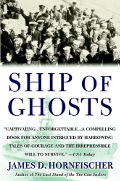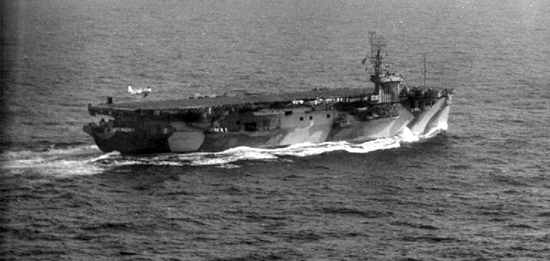Fighting the U-boats
Allied Navies
American Escort Carrier Development
The Atlantic CVEs
Prepared by Don Baker
The US Navy had studied the escort carrier concept in-termittently as far back as 1917. However, antisubmarine warfare in the Atlantic and small aircraft carriers received little attention during the pre-WW II period. During the 1930's and the period leading up to WW II, the Navy's eyes were on the Pacific and Japan's expansionist policies in SE Asia. The need, as the Navy saw it, was for large, fast, long range attack carriers with great sea keeping ability; there was no interest in and no plans for small escort class carriers. However, as a former Asst. Secretary of the Navy, President Roosevelt was no stranger to naval planning and in 1940 he was carefully watching, indeed actively assisting, the British Navy's war against the U-boats in the Atlantic.
USS Long Island - First of the CVEs
The first step toward creation of the escort class carriers occurred in October 1940, a year before the United States entered the war. President Roosevelt directed the Chief of Naval Operations to obtain a merchant ship for con-version to an aircraft carrier; the purpose of such a ship being to carry aircraft for convoy escort duty and anti-submarine operations. In January 1941, in response to President Roosevelt's directive, the Navy presented a plan, subsequently adopted, in which the Maritime Commission would make available the C-3 diesel ships Mormacmail and the Mormacland for conversion. Mor-macmail was converted at a cost of $1,500,000 at the Newport News Shipyard and commissioned on 2 June 1941 as USS Long Island, the first of the CVEs.
Mormacland was similarly converted and delivered to the British Navy as HMS Archer in November 1941. Four additional carriers of this class were built and transferred to the British Navy. The specifications for this class carrier are shown below:
Long Island Class - 5 built - C-3 conversions
| Displacement |
14,055 tons full load | |
| Dimensions | 465' wl, 102' ext.beam, 436' flight deck Machinery Single screw, 8,500 shp diesel, 1 catapult, 1 elevator | |
| Fuel Capacity | 1,429 tons | |
| Speed | 16 knots | |
| Armament | 1-5"51, 2-3"50, 20-20mm | |
| Crew | 970 | |
| Air Complement | 21 Aircraft |
Long Island CVE-1 was used extensively for experimental purposes and the tests indicated the need for a second elevator, longer flight deck, and increased anti--aircraft armament.
USS Charger - one of a kind
One of the C-3 conversions was returned by the British to the US Navy in March 1942 after having gone through further modifications and was commissioned as USS Charger CVE-30. USS Charger was scheduled to provide air cover for Operation Torch, the Allied North African landings in late 1942, but was replaced in that role by USS Santee before Operation Torch took place. Charger was then used as a training ship throughout the remainder of the war.
Charger Class - 1 of class
| Displacement |
15,126 tons full load | |
| Dimension | 465' wl, 111' ext.beam, 436' flight deck Machinery Single screw, 8,500 shp diesel, 1 catapult, 1 elevator | |
| Fuel Capacity | 1,295 tons | |
| Speed | 17 knots | |
| Armament | 1-5"51, 2-3"50, 10-20mm | |
| Crew | 856 | |
| Air Complement | 21 Aircraft |
The Bogue-class Carriers
The design of the Bogue-class carriers, based on the C-3 merchant hull, drew heavily on the operational experience gained with the Long Island. Propulsion was changed from diesel engine to steam turbine which gave a small increase in speed. Fuel carrying capacity was doubled, the flight deck length increased and a second elevator provided. However, the sheer in the C-3 main deck was retained which gave plane handling problems on the hanger deck.
Bogue Class - 44 built, (33 transferred to British Navy)
| Displacement |
13,890 tons full load | |
| Dimension | 465' wl, 111' ext.beam, 442' flight deck Machinery Single screw, 8,500 shp steam turbine, 2 catapults, 9 arresting wires, 3 barriers 2 elevators |
|
| Fuel Capacity | 3,420 tons | |
| Speed | 18 knots | |
| Armament | 2-5"38, 20-40mm, 27-20mm | |
| Crew | 890 nominal | |
| Air Complement | 28 aircraft max., 20-23 usual complement |
The Sangamon-class Carriers
The 1942 carrier program authorized 24 escort class aircraft carriers. However only 20 C-3 class hulls were available. Four Cimmaron-class fleet oilers were also converted to make up the difference. Sangamon, first of the oiler conversions, and Santee were commissioned in August 1942, followed by Suwanee and Chenango in Sept 43. These ships, almost twice the size of the Bogue-class carriers, made nineteen knots with twin screws. Two squadrons of aircraft could be carried.
The completion of the four Sangamon-class carriers was rushed so these ships could participate in Operation Torch, the Allied invasion of North Africa late in 1942 during which they provided air support. During this operation, aircraft from Santee attacked and damaged the French submarine Meduse which was later beached; aircraft from Suwanee sank the submarine Sidi-Ferruch.
Upon completion of Operation Torch, Suwanee, Chenango, and Sangamon departed the Atlantic for Pacific duty. The Santee remained in the Atlantic until early 1944 when she too was re-assigned to Pacific duty.
The Sangamon-class ships were considered highly successful as aircraft carriers and had sufficient numbers of oiler hulls for conversion been available the Kaiser-carriers (Casablanca-class) might never have been built.
Sangamon-class - 4 built
| Displacement |
23,875 tons full load | |
| Dimension | 525' wl, 114' ext. beam, 503' flight deck Machinery Twin screw, 13,500 shp, steam turbines 1 catapult (2 after 1944), 2 elevator |
|
| Fuel Capacity | 4,780 tons | |
| Speed | 18 knots | |
| Armament | 2-5"38, 8-40mm quads, 14-40mm twin, 21-20mm | |
| Crew | 1,080 | |
| Air Complement | 2 squadrons, 30 aircraft |
The Casablanca-class carriers
Henry Kaiser, west coast shipbuilder, originally pro-posed directly to BuShips a new class of escort carrier capable of 20 knots which by using assembly line pre-fabrication welding techniques could be mass produced. While generally referred to as a "Kaiser design", the design was actually by Gibbs & Cox Naval Architects. Admiral King, who was at this time in command of all U.S. naval forces, opposed Kaiser's plan and the building of this class of ship. Getting nowhere with the Navy, Kaiser took his plan directly to President Roosevelt. The President intervened and directed the Navy proceed with the Kaiser proposal. After discussions between the Maritime Commission and naval planners it was decided the Kaiser-design was unsatisfactory and to proceed with a similar ship based on a modification of the S4-S2-BB3 merchant hull. Fifty ships were ordered to be built by the Kaiser yards in Vancouver, WA on the Columbia River. As they came off the ways, the hulls were towed down river to the commissioning yard at Astoria, OR. USS Casablanca CVE-55, first of the class, was commissioned 8 July 1943. The building program was completed 8 July 1944. During this period, fifty of the Casablanca-class carriers were built at an average rate of almost one ship a week.
The Casablanca-class carriers were notorious for their hard rolling characteristics. They were considered unsuitable for North Atlantic operations and most of these carriers were assigned Pacific duty. Of the fifty carriers of this class built, only five were assigned Atlantic duty and of these five only one, Mission Bay, remained on anti-submarine duty to the end of the war.
Casablanca-class - 50 built
| Displacement |
10,900 tons full load | |
| Dimension | 490 wl, 108' ext. beam, 477' flight deck Machinery Twin screw, 9,000 shp, Skinner Uniflow reciprocating steam engines 1 catapult, 2 elevators, 9 arresting wires, 3 barriers |
|
| Fuel Capacity | 2,279 tons | |
| Speed | 19- 20 knots | |
| Armament | 1-5"38, 4-40mm quads, 20-20mm | |
| Crew | 860 | |
| Air Complement | 1 squadron, 21-23 aircraft |
Commencement Bay-class
The success of the Sangamon-class carriers resulted in the decision to build an improved version with increased AA armaments for use in the Pacific war. Begun late in the war, few of these ships saw action. Of 35 ships planned, only 19 were commissioned; of the remainder, either the hulls were not completed or the building plans cancelled at the end of the war in August 1945. None of these ships served in the Atlantic. However, CVE-106, the second ship of this class, was commissioned as USS Block Island, named after USS Block Island CVE-21 sunk in the Atlantic by U-549 in May 1944.
Commencement Bay-class - 19 built
| Displacement | 24,275 tons full load | |
| Dimension | 525' wl, 105' ext. beam, 502' flight deck Machinery Twin screw, 16,000 shp, steam turbines 2 catapults, 2 elevators | |
| Fuel Capacity | 3,134 tons | |
| Speed | 19 knots | |
| Armament | 2-5"38, 12-40mm quads, 24-40mm twin, 20-20 mm | |
| Crew | 1,066 | |
| Air Complement | 2 squadrons, 34 aircraft |
The Atlantic CVEs
Eighty six CVE's were commissioned in the US Navy dur-ing the war. Eleven of these ships were assigned to the Atlantic in the role of submarine hunter:
|
Sangamon-class, Bogue-class, Casablanca-class |
Santee, already deployed in the Atlantic, was joined by the Bogue and her in-class sister ships. Bogue arrived in Norfolk, VA for Atlantic convoy escort and anti-submarine duty in Jan 1943 followed by Card one week later. Core arrived in June 1943, Croatan in August, and Block Island in October 1943. These were the first of the American CVEs to fight the U-boats. In the period, May through December, 1943 these carrier groups, working closely with Tenth Fleet support, sank 27 U-boats.
The Atlantic sub hunters were joined by the Casablanca class carriers just beginning to enter service in late 1943. Mission Bay and Guadalcanal arrived in Norfolk about one week apart in January 1944 followed by Tripoli, Wake Island, and Solomons over the next two month period.
While the American escort carriers are associated primarily with "Hunter-Killer" operations in which a carrier task group roamed the central Atlantic hunting down U-boats, most of these carriers initially served as in-convoy escorts or operated removed from but in direct support of the convoys. The "Hunter-Killer" role evolved later and it proved to be an operational tactic in which the escort carriers excelled.
The 11 American Atlantic escort carrier task groups sank a total of 53 U-boats and captured 1 in the two year period from May 1943 to the end of the war in Europe, May 1945. One carrier, Block Island, was sunk with the loss of six lives by U-549 which was then itself sunk during the ensuing battle with Block Island's escorts.
Bibliography
Hunter-Killer
William T. Y'Blood
Naval Institute Press, Annapolis
The Little Giants
William T. Y'Blood
Naval Institute Press, Annapolis
The Tenth Fleet
Ladislas Farago
Richardson & Steirman, New York
The Atlantic Campaign
Dan van der Vat
Harper & Row, New York



